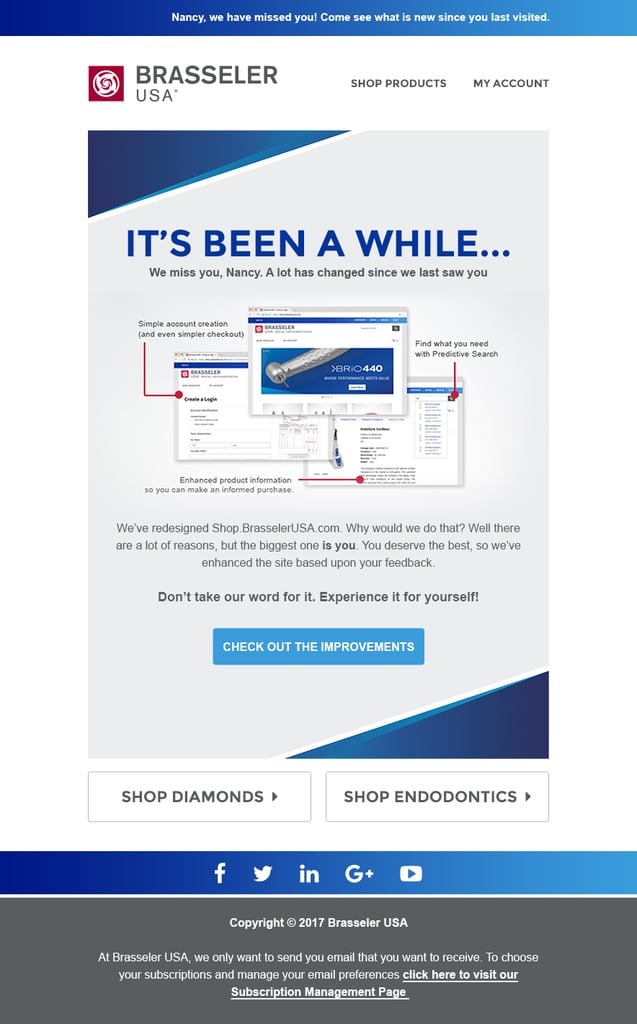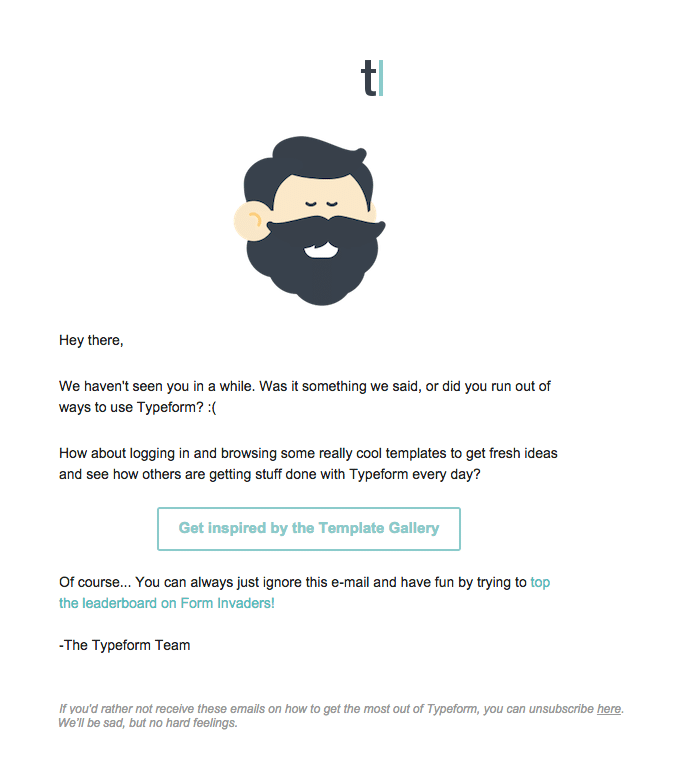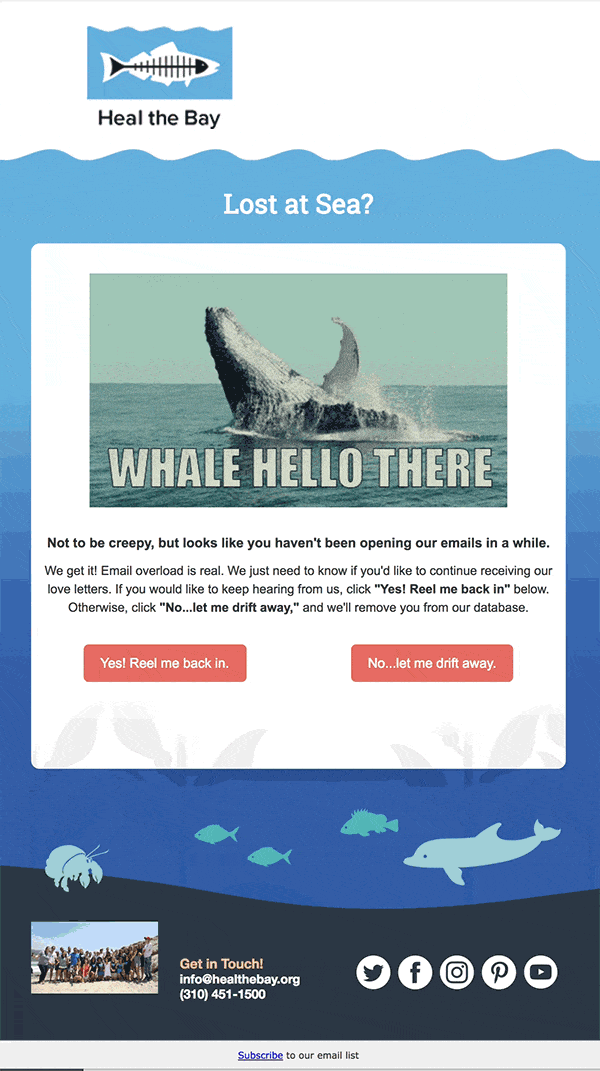How to send an effective re-engagement email
This post was updated in January 2019.
Win back lost subscribers with a timely re-engagement campaign
Your subscribers will never be more engaged than the moment they join your list.
Maybe they just learned about your brand, or they're fired up about whatever lead magnet you offered in exchange for their subscription. In an ideal world, your emails would continue to provide so much value that they'd always open everything you send.
But unfortunately, not every subscriber will stay engaged. For one reason or another, they might stop opening or clicking on your emails – it happens to the best of us. So if you've accumulated a group of inactive subscribers, it's time to send a re-engagement campaign.
A study by Return Path found that 45% of recipients who received win-back emails read subsequent messages. And if they don’t, that’s perfectly fine. You’ll have a cleaner list, more reliable data, and an unsubscribe is always preferable to someone sending you to the spam folder and hurting your sender reputation.
So, let's show you how it's done.
Figuring out who to send to
What I consider an "inactive subscriber" might be different from what your team does, and the definition will naturally vary across brands and industries. In a post from Litmus, they recommend thinking about the following as you determine your parameters:
• Types of behavior: While most people generally focus on opens and clicks (or rather, the lack thereof) while choosing an audience for their re-engagement campaign, you can also consider behavior on your website and purchase history.
• Frequency: Consider longer or shorter timeframes for inactivity based on your send frequency. If you send daily, you might want to narrow down your focus to anyone who hasn't engaged in 90 days, whereas a professional organization that sends a monthly newsletter may need to track a longer timeframe, like 6 months.
• Customer lifecycle: If your customer lifecycle is long (as is often the case for B2B companies or brands that sell higher-dollar items, like luxury goods or vacation packages), you'll want to consider a longer inactivity time frame to mirror that behavior.
What to put in your campaign
Once you've built your segment of inactive subscribers, it's time to brainstorm content and build your re-engagement email. Here are some ideas to consider as you craft your campaign:
Make it valuable. While coupons and monetary incentives can work well in the retail space, other industries should try to offer the type of value that will help drive engagement in the long term. Some ideas? Include an invitation to an in-person event, offer membership to a VIP rewards program, or provide access to a free educational course. Or, if your product or service has changed significantly since they signed up, simply make them aware of your latest offerings.
Own your brand. You have a distinctive brand voice and style, and now's the time to really flex those creative muscles. Remind people why they decided to sign up in the first place by bringing out your very best design and copy chops. Pro tip: An element of humor or self-deprecation can often help your re-engagement email stand out and capture attention.
Ask what you're doing wrong. A lack of engagement from your email subscribers often signals something off with your email marketing, whether it's an overzealous send cadence, poor mobile design, or irrelevant offers. Course correct by simply asking subscribers what they want (or don't want) from your brand in the body of your re-engagement email.
After it's all said and done
After you've sent your re-engagement campaign, gather your data. First and foremost, if you asked for feedback, be sure to integrate it into your strategy moving forward. Then, you have couple of different options for dealing with the portion of your audience who still didn't respond.
One route is to segment out the subscribers who don't open or click on your re-engagement campaign and bench them for a while. Then, you can send them another re-engagement campaign at a later date.
We tend to prefer a different approach, though: Let go of your inactive subscribers altogether. It will be a little painful to watch your list shrink, but it's for the best. Maybe the email addresses you're sending to aren't valid (this happens all the time in the B2B space as people change jobs), maybe your subscribers never check the inbox you're sending to, or maybe they just sincerely don't want to hear from you.
Regardless, you won't accomplish anything by sending to people who don't open your emails.
What does success look like?
It can be difficult to make the case for a re-engagement campaign when your higher-ups aren't typically involved with email. After all, reducing your audience for any reason seems like it would be a bad thing. And while you can argue that your open rates will be higher afterward, that's a bit of a vanity metric: Of course your open rates will be higher if you stop sending to people who habitually don't open.
Instead, find other KPIs to demonstrate the success of your campaign. For instance, it could be a better deliverability rate or a lower spam complaint rate. These are both legitimate indicators that your re-engagement email had a positive, lasting effect on your email marketing success.
Great re-engagement examples
1. Loft
Here’s an example of a classic retail re-engagement email from my own inbox.
It’s attention-grabbing (we can’t help but stop when we see our name), and it makes the overall experience and offer feel like it’s tailor-made just for me.
Look at the copy. “It’s been awhile. Here’s a little gift to get you back in the mix.” It’s been a long time since I bought from them, so they’re taking that customer data (in this case, my last purchase date) and using it to send me a personalized offer. And guess what? I’ve bought from one of these emails before. You’ve probably bought from one of these emails before. If you work in e-commerce, you should absolutely be sending this kind of email.
2. Heal The Bay
But let's say you aren't a retailer. Here’s another example from Heal the Bay, a nonprofit organization that works to protect the coastline and urban waterways in Los Angeles County.
The lighthearted, pun-filled email is the perfect way for Heal the Bay to clean up their list, improve deliverability, and show subscribers they’re paying attention. Plus, that GIF immediately grabs your attention, which is super important when you’re trying to win back a subscriber who may have tuned out. The whole vibe is a good reminder that, oh yeah, I like this organization. Let me see what they’ve been up to lately.


If a company like Brasseler can send a compassionate and compelling re-engagement email, so can yours.
5. Typeform
Finally, Typeform has done a great job of segmenting engaged users from inactive users, and they've sent this email specifically to those who haven't used their platform in a while.

Why re-engagement emails are so important
Remember: One way ISPs like Gmail and Outlook determine whether or not incoming email is spam is by monitoring how engaged recipients are with a marketer’s messages.
If you want to preserve your sender reputation and avoid the spam folder, there comes a time when inactive addresses simply have to be removed. A re-engagement campaign serves as a final effort to hang onto those hard-won subscribers before you say goodbye for good.
MOST RECENT ARTICLES
Want to engage your audience and grow your brand? Try Emma's robust easy-to-use product today.














